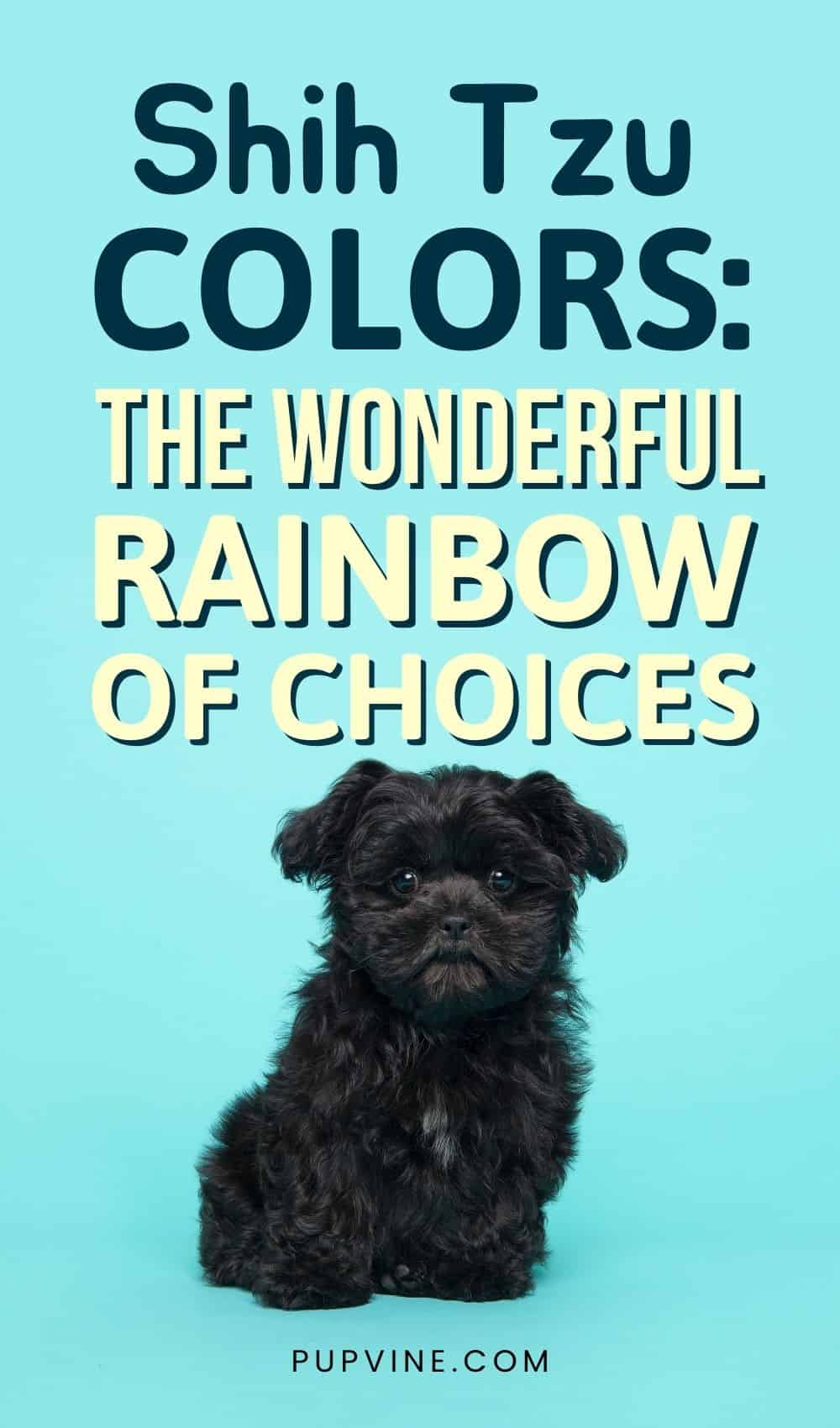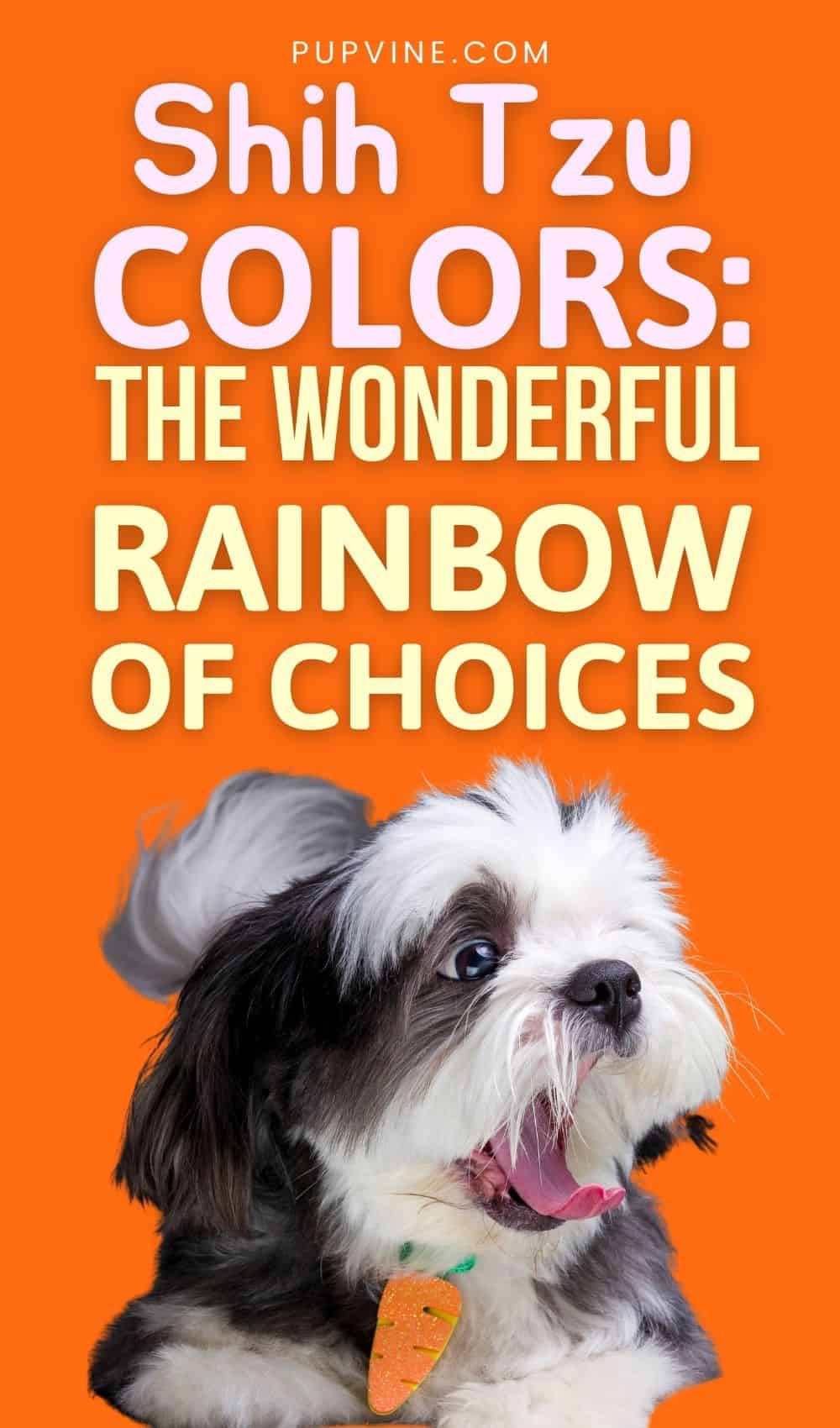Shih Tzus are one of those dog breeds that have numerous coat color varieties. The rainbow of Shih Tzu Coat colors is something that fascinates many dog lovers and all Shih Tzu owners. Once a future dog owner realizes how many different colors these adorable pups come in, the decision of which Shih Tzu to bring home becomes quite difficult.
Today, we’re bringing to you all Shih Tzu breed color variations to make your decision a bit easier. Will you choose a liver Shih Tzu? Will a red & white one be your choice? How about a black dog?
Let’s see all the common colors this dog breed sports as well as some rare varieties.
A Word About Official And Unofficial Colors
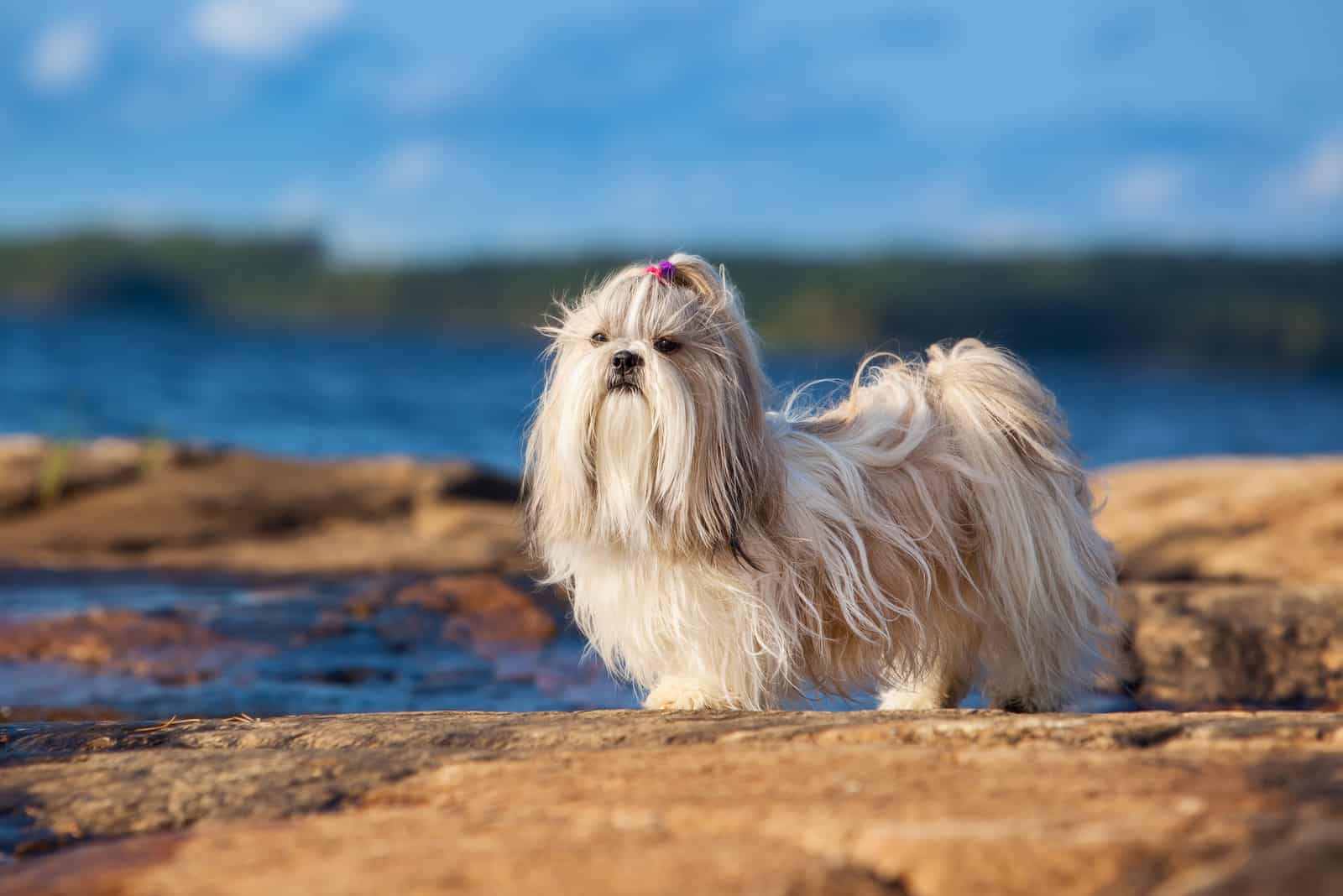
“All Shih Tzu Coat Colors are permissible,” says the breed standard set by the American Kennel Club.
“All colors are permissible, a white blaze on the forehead and white tip to tail are highly desirable in parti-colors.” The Kennel Club in the UK agrees.
“All colors are acceptable, but black noses, lips, and eye rims are a must.” The Canadian Kennel Club confirms.
Also, the FCC (Fédération Cynologique Internationale) claims: “Colour: All colors are permissible, a white blaze on the forehead and white tip to tail are highly desirable in parti-colors.”
When a potential dog owner first looks at a Shih Tzu dog or puppy, they’ll see many color variations characteristic of this dog breed. Unlike many other dog breeds that come in only a few colors, the Shih Tzu breed comes in a rainbow of rich colors.
It can be quite confusing with so many coat colors, patterns, and markings. Things get even more complicated once you learn that Shih Tzus’ colors may change over time.
What shouldn’t be your guideline when choosing a Shih Tzu is, actually, their color. Look for a dog with a good health status, nice personality, and loving temperament. These are much more important traits than color.
Lucky for you, Shih Tzus are usually quite endearing dogs and have excellent personalities.
All that’s left to do is pick a color.
Shih Tzus can be born with hair in a solid color or a combination of two or even three colors.
Another thing that makes everything complicated is that Shih Tzus may be registered with the American Kennel Club (AKC) based on the pigment of their skin rather than the color of their coat.
If a puppy is going to be registered with the American Kennel Club, the breeder has a choice of 8 solid colors, 7 varieties of two color combinations, 4 combinations of three or more colors, and numerous different types of markings with the combinations from above.
In your search for the perfect Shih Tzu, you may find out that there are Shih Tzu breeders that specialize in certain colors. Some breeders may only carry one coat pattern, while others can be devoted to breeding dogs with specific eye colors, i.e., blue eyes only.
However, you must know that many of these colors have other names, and some are even unofficial colors and are not recognized by official dog clubs.
Colors like lavender, chocolate, or Isabella aren’t official or standard Shih Tzu colors. In fact, these are all liver dogs!
Let’s start with the solids first!
Understanding The Breed: A Quick Overview Of The Shih Tzu Breed
History
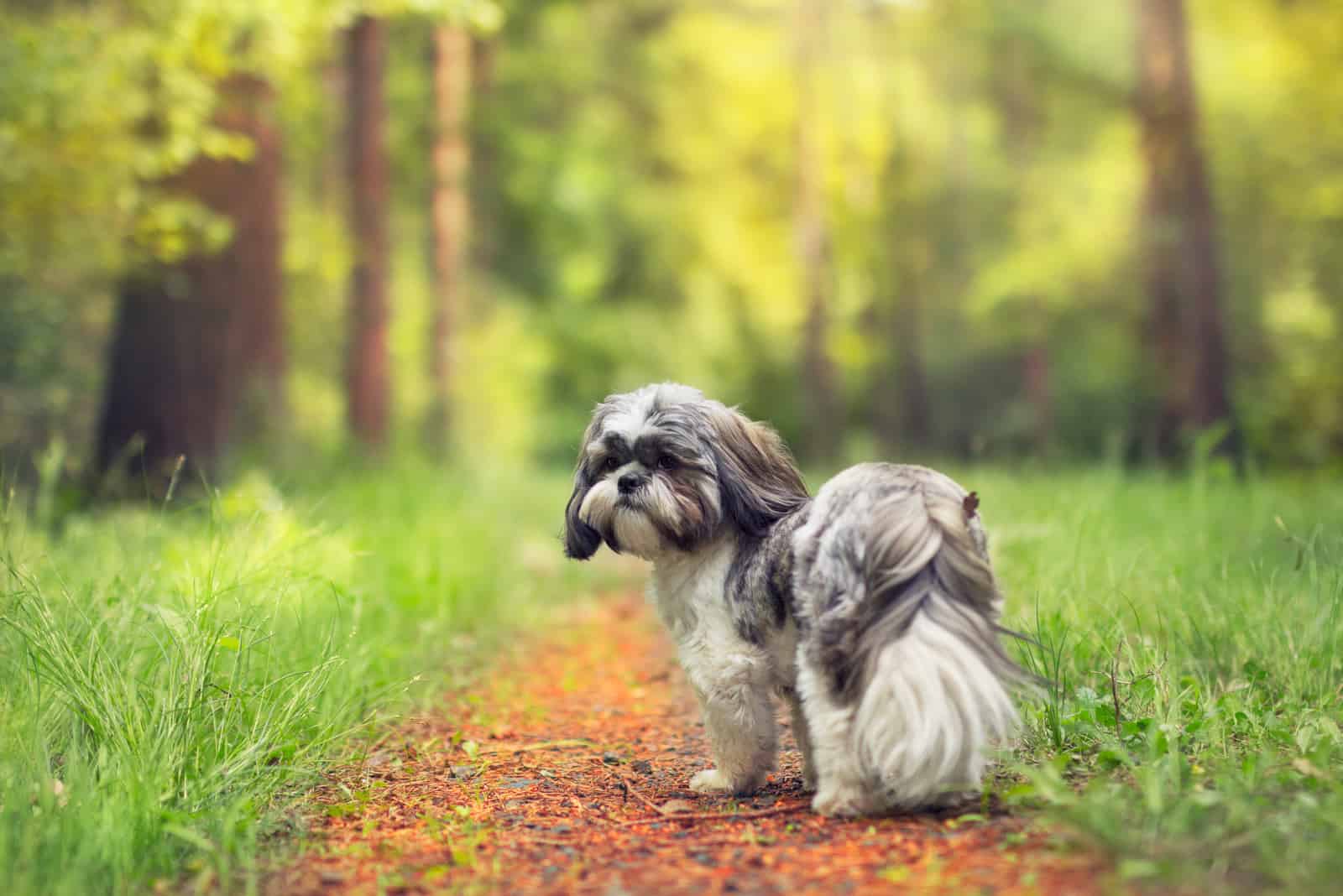
The Shih Tzu dog was bred to sit around the throne of the Emperor of China and bark when unknown people and animals approached to alert the people of the palace. Soon enough, the Shih Tzu became a favorite of the Imperial court as a companion rather than a working dog.
The existence of the Shih Tzu we know today is owed to Empress Dowager Cixi (Tzu-Hsi), whose kennel of Pugs, Pekingese, and Shih Tzu was world-famous.
It was not until 1930 that the first pair of Shih Tzus were exported outside of China to England. The breed almost became extinct after the Communist Revolution.
The returning military personnel brought back some of the first Shih Tzus to the United States during the late 1940s and 1950s and began breeding them. Soon enough, their charm and outstanding temperament found adoring fans. The Shih Tzu was recognized in Britain in 1946 and by the AKC in the United States in 1969.
Appearance
Shih Tzus are classified as toy dogs in most countries, with a height of only 8 to 11 inches and a weight of 9 to 16 pounds.
Like many other toy breeds, the Shih Tzu matures quickly, reaching adulthood at around 10 months old.
The Shih Tzu is slightly longer than it is tall, with a sturdy body and a nice-sized head. They have a short muzzle with an undershot bite. Their heads are round, and their eyes are very prominent.
They have a curled-up over the back tail and a long and swift gait for a small dog.
Shih Tzus have luxurious, long, and straight hair. Their double coat requires some upkeep, especially if it’s left long on these short dogs as it may sweep the ground.
Any Shih Tzu color is acceptable, but people prefer dark pigment around the eyes and on the nose.
This is a fairly hardy dog breed that lives up to 14 or 15 years of age!
Personality
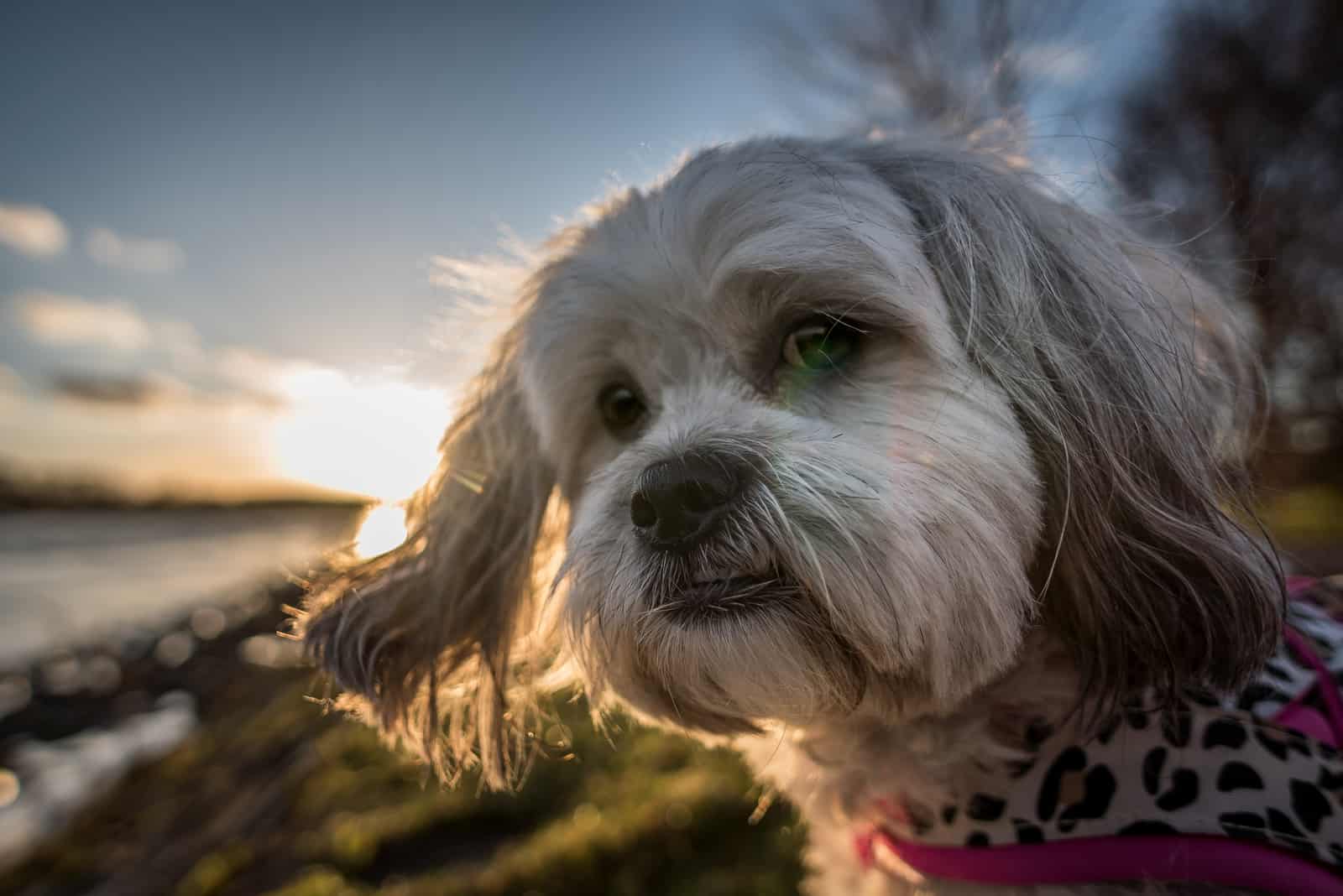
Shih Tzus are known for being perky and having happy temperaments. These dogs are very lively and friendly. They get along with people of all ages, as well as with other dogs or pets of different species. Most Shih Tzus are very lovely; you’ll hardly ever find one that acts aloof.
As they have short muzzles, Shih Tzus are not big chewers, but they do enjoy digging and barking. Their desire to be with people is huge, whether it’s only sitting on your lap or going for a walk in the park.
Living with a Shih Tzu
Shih Tzus are very easy to live with because of their lovely temperament. They’re one of the most beloved dogs in America. However, you do need to take care of a few things before they slip out of control.
First off, don’t feed them many treats. These dogs are prone to becoming obese. Combined with their medium-energy drive, you’ll see why it’s so easy for them to put on weight.
Shih Tzus don’t need walks that are too long, but they do enjoy some form of recreation to keep them fit. They often compete in obedience and agility training with great success. However, when exercising your Shih Tzu, be aware that humid weather and their short muzzle aren’t a good combination because it may cause a heart stroke.
Grooming a Shih Tzu is rather easy. Most Shih Tzu owners opt for a short coat, which looks lovely and is easy to care for.
Longer coats require serious grooming time.
Shih Tzus need weekly baths and oiling of the coat to stop it from matting. Also, don’t forget to brush them daily to get rid of any foreign objects that easily get trapped inside their fur.
Shih Tzus need lots of attention every day. They love human company and love being spoiled even more! Training and learning tricks are something they enjoy immensely as they’re the center of attention.
One thing these pups aren’t so good at is being a guard dog. It’s more likely your Shih Tzu will welcome the burglar by giving him wet kisses than by barking at him.
What Is The Best Color For Shih Tzu?
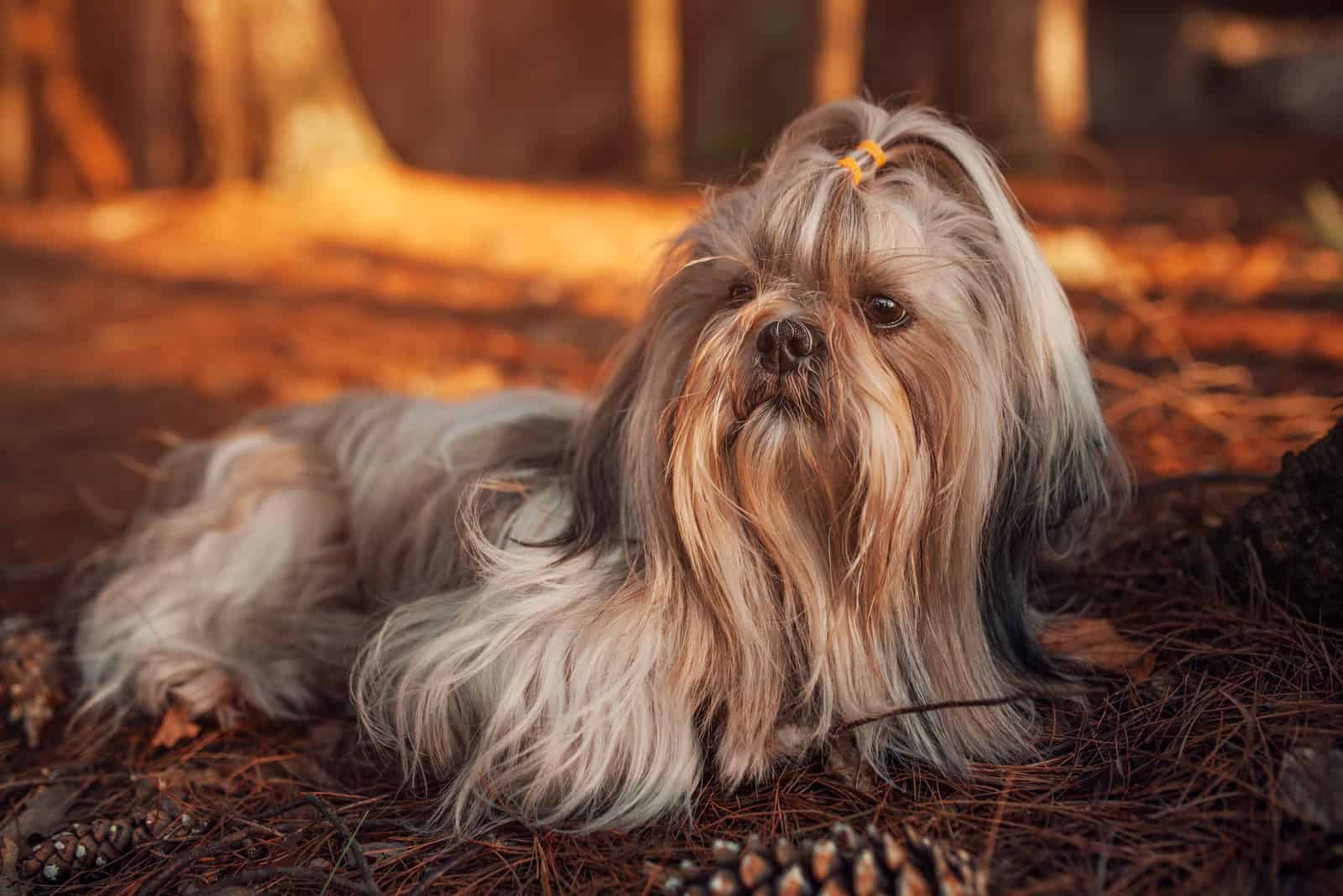
The answer may surprise you.
It’s all of them!
In fact, color has nothing to do with how healthy your Shih Tzu puppy may be or how it will behave. Color is purely decorative.
However, there are some preferences when it comes to taking care of the Shih Tzu as well as grooming them. It’s rather obvious that a white Shih Tzu will get dirty easily. A solid black one would be a lot easier to take care of.
White markings over the face or on the chest may also be difficult to handle because food can easily get trapped around their mouth, and there’s the annoying part of wiping tear stains.
So, if you’re already too busy or don’t have any experience in grooming dogs, maybe you should check out some dark solid Shih Tzus or the color combinations that exclude white.
All in all, all colors are ideal for a Shih Tzu; you just need to figure out which one is ideal for you!
Now that you get the general picture of what Shih Tzus are really like and how they behave, let’s finally talk about something pretty… Shih Tzu colors!
Shih Tzu Colors Chart
| Solids | Bicolor | Tricolor |
|---|---|---|
| black | black and white | silver, gold, and white |
| white | blue and white | silver, black, and white |
| blue | silver and white | black, gold, and white |
| red | red and white | black, silver, and gold |
| silver | gold and white | / |
| gold | brindle and white | / |
Solid Shih Tzu Color: Black
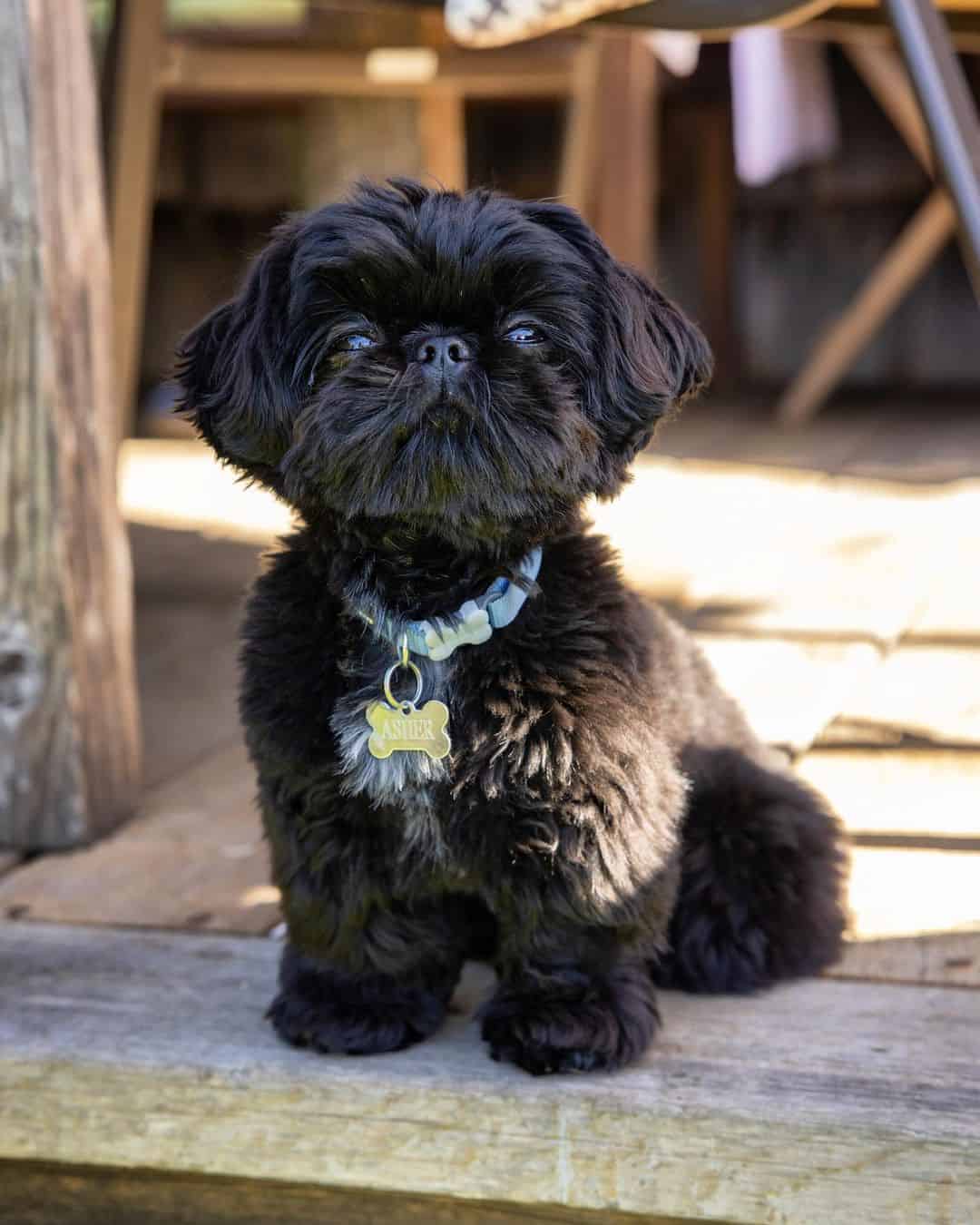
Photo from:@asherisawesome
A solid black Shih Tzu puppy is also known as a Prapso Shih Tzu. Black is the most dominant color, and a true black Shih Tzu will have no other colors in the coat. Even if there’s the slightest trace of another color, the dog will be considered a two-colored one.
Shih Tzus with a black coat will have a black nose too.
There are rumors online that black Shih Tzus aren’t purebred and that such puppies must be mixed dog breeds. This is completely wrong. Black Shih Tzus are just very rare.
Some people are ready to pay more money for a solid black Shih Tzu. But, it doesn’t mean this dog is a rare one. They’re more likely to be less common and harder to find.
The color of a dog’s coat depends on genetics. There are two pigments present in each dog, eumelanin color and pheomelanin color.
Eumelanin shades are black, lilac, chocolate, and blue, while pheomelanin varies from cream to red.
A dog’s basic color can either be a solid eumelanin coat or a non-solid one, meaning it has markings. Markings depend on the K locus consisting of three alleles.
The Kb allele means black is dominant, Kbr means brindle, and Ky means recessive non-black.
In other words, a solid black dog will have Kb Ky or Kb Kb alleles.
Since a solid black Shih Tzu is a desirable one for easy upkeep and grooming, as well as a lovely appearance, we can say this is probably the most popular of all Shih Tzu colors. But, truth be told, all Shih Tzu colors are equally beautiful.
Solid Shih Tzu Color: White
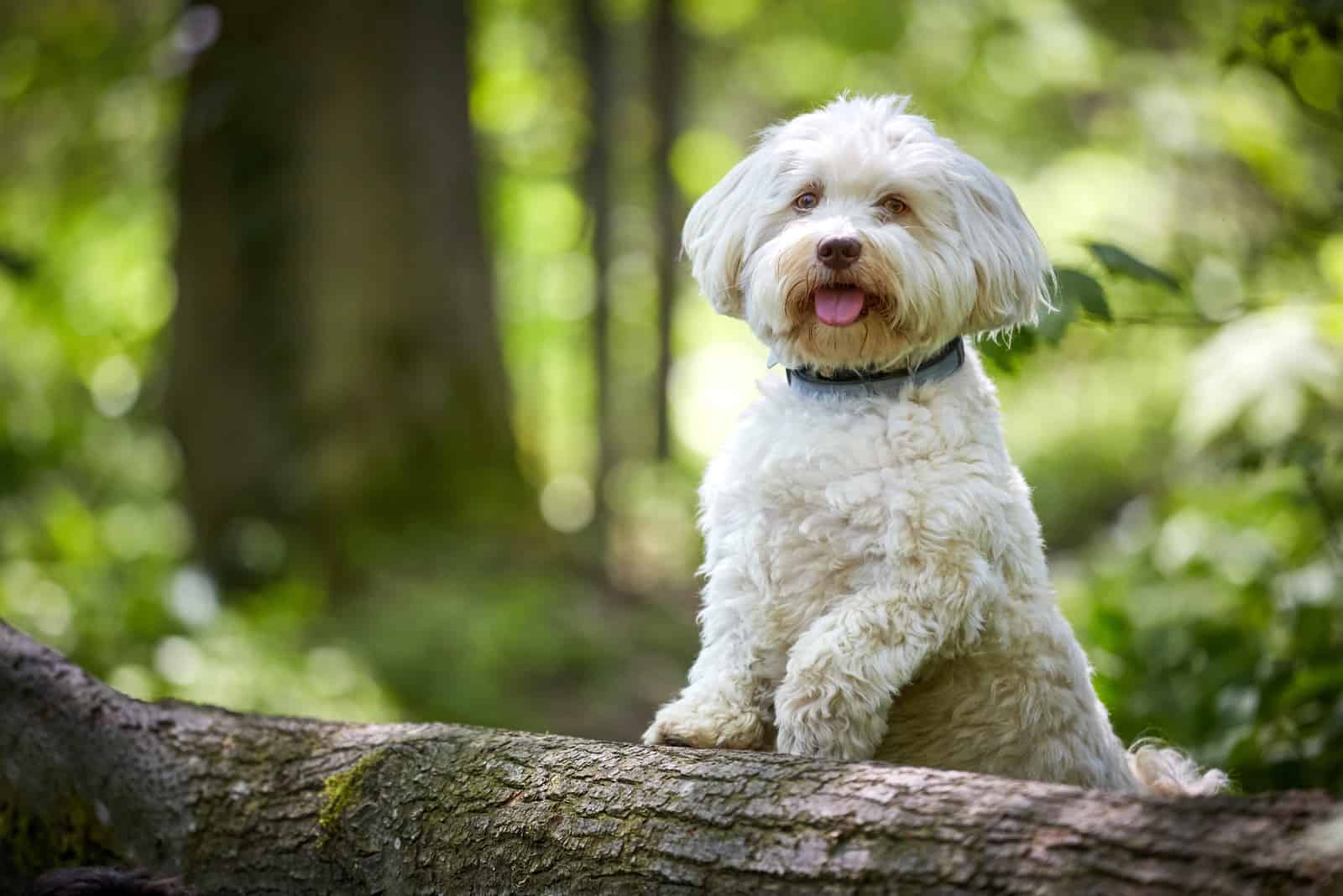
A white coat is similar to a black coat in that it only has one color and no traces of other colors. These Shih Tzus have a black nose. In fact, all Shih Tzus, but the liver color ones, will have a black nose.
The American Kennel Club is a bit strict on breeders with puppies that are not pure white but rather cream. Cream is not an official option, so cream Shih Tzus can only be noted as white Shih Tzus in official papers.
Solid white is an extreme piebald. It is produced by the piebald gene, which is recessive. Both parents must have it to produce white puppies. But still, color genes from generations back are still in play, affecting the colors of the litter.
Most breeders don’t aim to produce purely white Shih Tzus. What they strive for is white with other color accents. Most Shih Tzus will have white as their base color, with another color or two complementing the coat. Those other colors may be gold, black, red, silver, etc.
Silver, Red, And Gold Shih Tzus
A silver coat looks more like white with a deep shine resembling silver. This is not a grey color, but it’s rather a shiny, silky color. Silver Shih Tzus will have black lips, pads, eye rims, and a black nose.
To recognize the silver Shih Tzu, the coat must be a shade of gray or off-white. This coat shines under the sun.
Red is a solid color that looks more deep, dark, and orange. This Shih Tzu will have a black nose and black eye rims, lips, and paw pads.
The gold solid color resembles a tannish-yellow. However, there’s a wide range of shades, from light tan to deep gold.
Shih Tzu Colors: Brindle
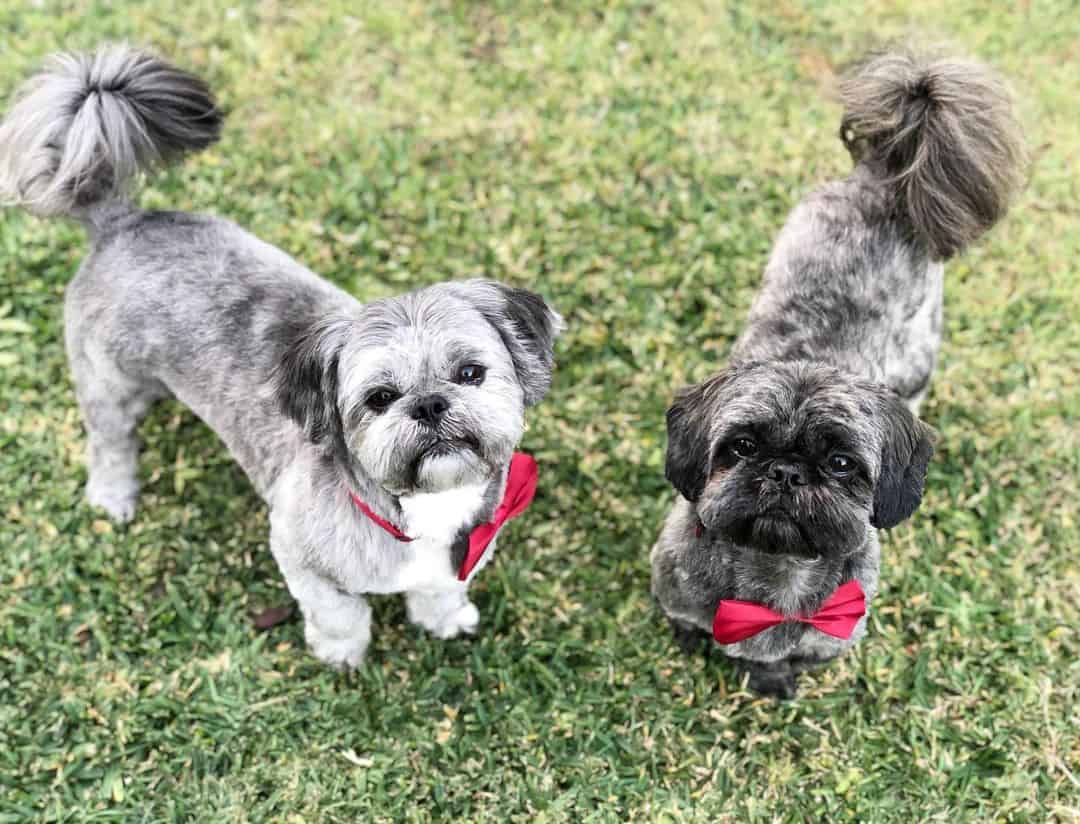
Photo from: @hello.teddy.ziggy
Brindling occurs as a complex reaction to several genes found at different locations on the gene. Brindle is a combination of one color and streaking of another running throughout the coat, i.e., gold-black brindle. Brindle is not a color; it’s a color pattern that consists of gold, tan, grey, brown, or black stripes.
A brindle coat looks different in all dogs. Some stripes are thicker and wider, while there are coats where the stripes appear to be very narrow.
If the brindle pattern includes liver or blue colors, the dog will be considered liver or blue. A true brindle Shih Tzu will have black eye rims, a black mouth, and black paw pads.
Puppies can have a brindle coat, but that coat can turn into something else as the puppy matures.
Shih Tzu Colors: Liver
The liver color comes from a recessive gene. For a puppy to be liver, both parents must carry this gene.
Liver is a confusing coat color because of the points like the dog’s nose, eye rims, paw pads, and lips. They’re not the actual coat color. Only when these points are brown or liver color will the dog be labeled as liver.
Liver-colored Shih Tzus lack the black pigmentation of the skin. Their noses, paw pads, and other points may be brown, but their hair color can vary from very light brown to deep chocolate and everything in between.
Liver Shih Tzus can range from a light red, orange, and cream to deep brown chocolate. That’s why it’s possible to have a white-liver, cream-liver, or even chocolate-liver.
Some liver Shih Tzus can have green eyes with this coloring, but this isn’t standard.
Blue Shih Tzu Colors
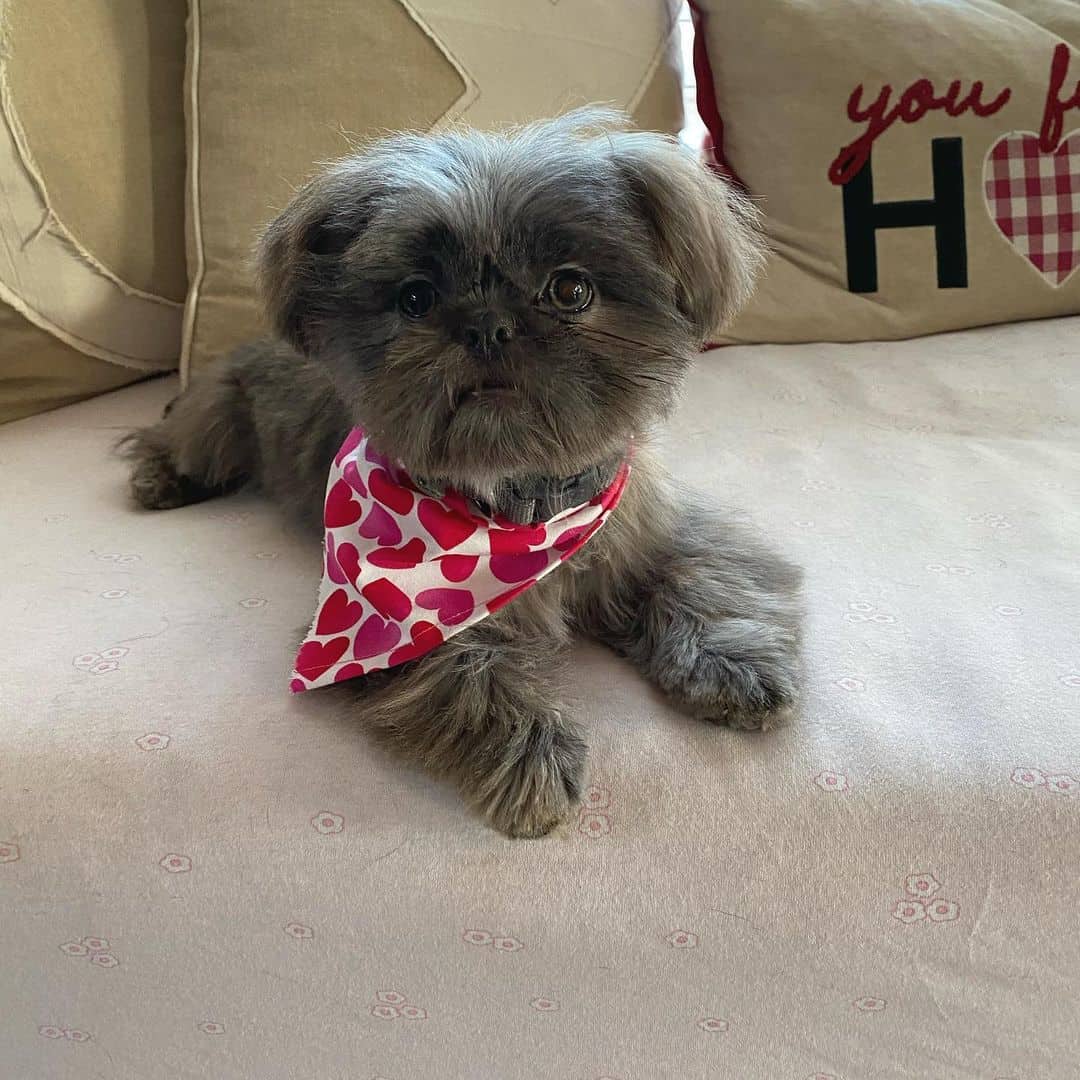
Photo from: @beau_williams2020
Blue is another confusing color. Blue is considered to be diluted from a genetic point of view. The dilution occurs when the black or brown pigment has been affected by an additional dilution gene. When this occurs, the pigment gets clumped differently and distributed irregularly.
If the pigment is black, the dilution will result in a blue color. If the pigment is brown, the result will be a silvery color named Isabella or lilac. Shih Tzu breeders also refer to this color as lavender.
The AKC does recognize the blue color, but not Isabella or lavender as a part of their standard.
A true blue Shih Tzu will have a blue nose, but it can have other hair colors. The color looks more charcoal, and it’s difficult to see except in natural light. It would be best to visit a groomer before buying a puppy to see the dog’s color in the sunlight. Buying based on a photo on the Internet can give you the completely wrong impression of your future dog.
Shih Tzu Coat Colors: Two Color combination
There are seven varieties of colors that contain two combinations. It’s always white with another color.
Those variations are:
• Black and white
• Blue and white
• Silver and white
• Red and white
• Gold and white
• Brindle and white
• Liver and white
One of the Shih Tzu coat colors that come as a combination of white and another color is white and red or gold. However, this color combination does not appear on the AKC‘s official registration paperwork, even though it exists.
Two-color combinations have endless pattern possibilities. There are no two identical Shih Tzus. Symmetry in color combinations is desirable, but it’s not mandatory. You can rest assured your two-color Shih Tzu will be a unique pooch!
What’s so interesting about double-colored Shih Tzus is that the colors may change as the dog matures. Light colors may become darker, and dark colors may fade.
Some cases show that the color may change completely. For example, a black and white Shih Tzu may grow into a silver and white one. Or, red and white may change into a gold and white Shih Tzu.
Many people debate if there is any difference between, e.g., a silver and white Shih Tzu and a silver dog with white markings. This can only be determined by the breeder who is registering the puppy.
In most cases, white is only a small patch of color. But, if the color appears on 30 to 40% of the body, it is classified as a two-color coat.
In addition, what once started as a color marking may end up as clearly a second color. Large color patches may fade too. Genetics are funny in that way. You never know how your adult Shih Tzu will look. That’s why buying based on the puppy’s current color isn’t advised. You should always check out the parents, too, if you have a chance.
Shih Tzu Colors: Black And White
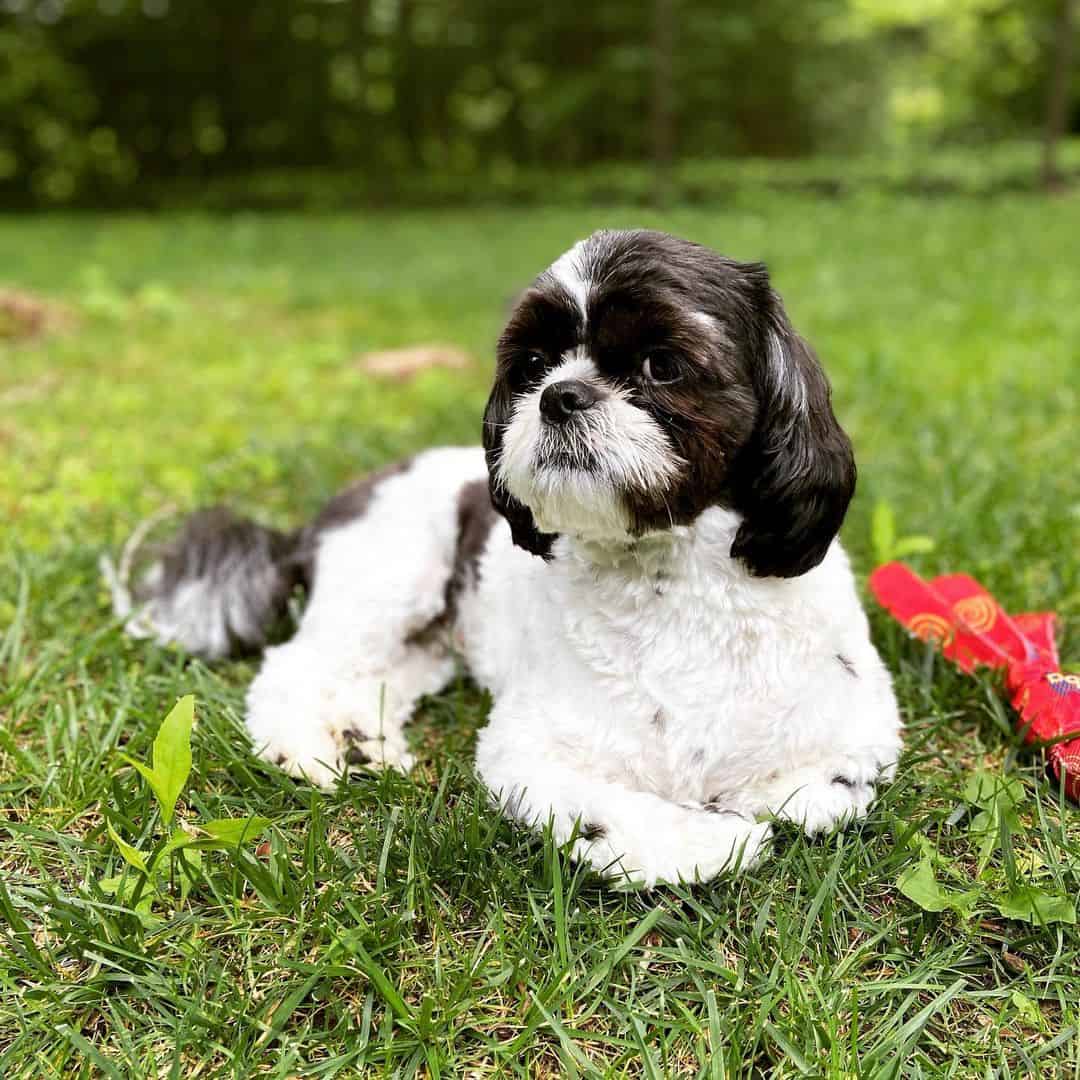
Photo from: @oscar.the.happy.shihtzu
A designation of black and white includes all dogs with black and white markings. A term you may have encountered before is piebald.
The white that appears on a black and white dog is determined by the gene on the S locus. White spotting or white areas can include any color, even black. White hair occurs when the skin cells can’t produce any pigmentation, resulting in pink skin and white hair. These dogs have white nails and paw pads.
Tricolor Shih Tzu Colors
Shih Tzu dogs can also have a combination of three colors. The most common of these include:
• Silver, gold, and white
• Silver, black, and white
• Black, gold, and white
• Black, silver, and gold
Per the AKC breed standard, any color and marking are permissible. No color is preferable to another. So, the possibilities for a tricolored Shih Tzu are endless.
White commonly appears in a Shih Tzu with a tricolor coat.
It’s much rarer to see a black, tan, and gold Shih Tzu than a black, gold, and silver one.
Did you know that brindle can be one of the three colors in the combination? Brindle, white, and tan will have brindling along with white and tan, resulting in a coat of five colors!
Also, tricolor may develop or fade away. This dog breed often goes through remarkable color changes. A Shih Tzu born with only two colors may end up as an adult with a tricolor-combo.
Or, a Shih Tzu puppy may sport three colors, but as it matures, one of the colors may fade away and leave the puppy with a parti coat.
Unique Coat Markings
Aside from the many Shih Tzu coat colors and patterns, there are some unique markings you may like to know about.
Black Mask

Photo from: @masato.oolong
The black mask you see on superheroes is quite different on a Shih Tzu. Sometimes these dogs may have black coloring on the muzzle, which may extend to their eyes, ears, and even up towards the forehead.
This is called a black mask. The rest of the hair can be another color like red or gold.
Dobie Colored Shih Tzu
Dobie markings are quite rare, and they occur when a puppy is born with a tan marking on a black or very dark coat.
These markings can be found above the eyes, on the jowls, the lower legs, and under the tail. Breeders that have puppies with Dobie markings will consider them as premium Shih Tzus and will ask for more money for them.
The term Dobie markings comes from the fact this coloration is often seen on the Doberman Pinscher.
The markings come from recessive genes, meaning both parents must carry this gene for the puppy to have these color markings. However, not all puppies in the litter will have Dobie markings.
Sometimes, not even one Shih Tzu puppy will get them!
Black Tips
Another interesting marking is when the coat hair has black tips. Usually, when a puppy is born, the coat can have one color, like red or gold, with black tips at the ends of the hair shaft.
This marking occurs all over the body and shouldn’t be confused by the black some Shih Tzus have on their ears.
Unfortunately, this black tipping will disappear after you give your dog their first haircut.
Still, the marking is quite striking and appealing in puppyhood. Perhaps if you let your Shih Tzu sport a long coat, you can enjoy this marking even longer.
Does A Shih Tzu Change Color?

We mentioned earlier that the Shih Tzu coat might change over time. This interesting phenomenon is something that makes the Shih Tzu color so complicated.
A Shih Tzu coat can lighten over time, which is called fading, or it may turn grey, which is called greying.
It’s not rare to see a color marked on the AKC’s paperwork for an eight-week-old puppy that’s totally different from the adult coat color. Meaning, the color you fell for in early puppyhood may change as the dog becomes an adult, somewhere around its first birthday.
It’s the genes that cause the change in the coat coloring. Two distinct genes will determine whether a Shih Tzu’s coat will become lighter or grey.
If the dog carries the G gene, the coat will fade as he gets older. You may notice fading in young puppies, even those who are only a month old. Sometimes, puppies will look almost black at birth, but by the time they’re ready to try solid dog food for the first time, their coat color will have changed. The color changes will continue until the dog reaches his first birthday.
Greying happens when the Shih Tzu carries the Chinchilla gene (CH series). The coat will change color, but it won’t be the same as with fading. The dog’s coat will turn a rich, silver color.
Related articles: Shaggy Dog Breeds
Rare Shih Tzu Colors And Patterns
You will hear lots of different terms to describe unique coat colors and markings Shih Tzus may have. Here are just some of the most common ones:
• Blaze: a strip of white hair up the center of the face, between the eyes.
• Flare: a wide blaze pattern that approaches the top of the skull.
• Collar or shawl: a marking around the neck, usually in white.
• Saddle: a large patch of color, usually white, over the back. It resembles a saddle on a horse.
• Tuxedo: a white patch of hair on the chest of a solid-colored dog. This color can also be found on the chin and feet. When you look at the entire picture, you’ll see these color markings resemble a tuxedo.
How To Choose A Shih Tzu Coat Color
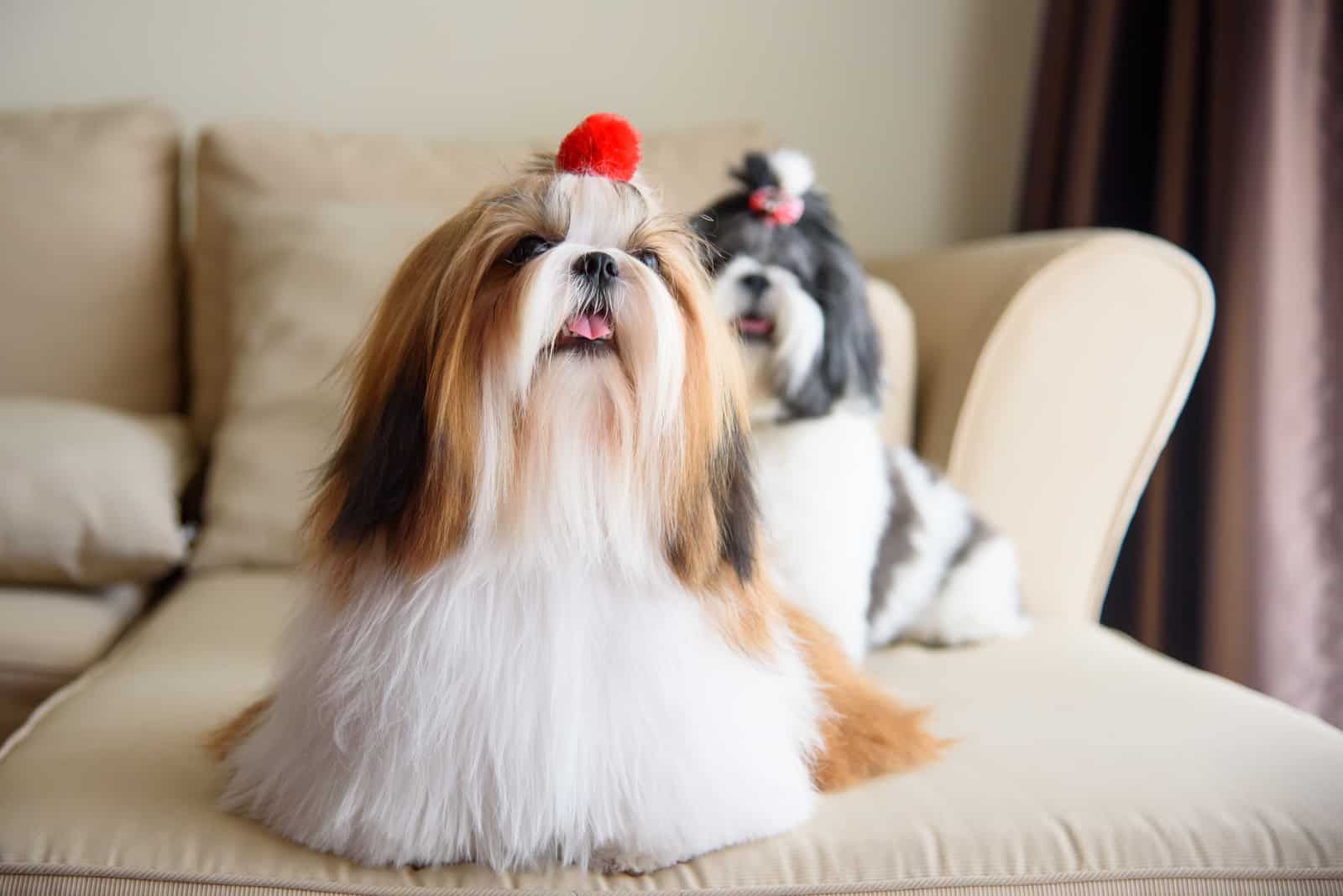
Choosing a Shih Tzu color is all about your personal preference. We get it. It’s hard to choose from so many amazing color options. But, you should keep in mind some facts about the colors presented to you.
It’s natural that of all Shih Tzu colors, white will be the most difficult to bathe and groom. Any other light color variation will also require strenuous effort to keep it clean. White markings around the muzzle or under the eyes can be easily stained with food and tears, so frequent washing will be necessary. If tear staining is something you don’t want to deal with, try choosing another Shih Tzu color.
When choosing a Shih Tzu color, you must keep your budget in mind. Shih Tzu puppies can cost from $1,200 to $3,000. If you want a rare color or a specific pattern, you’ll need to fork out more cash.
All Shih Tzus are beautiful. The beauty in different Shih Tzu coat colors is only skin deep. Shih Tzus are generally loving creatures that can be your best buds for a long time. Their lifespan is an amazing 10 to 16 years!
Have you decided which Shih Tzu color is your favorite yet?
Read Next:
The Complete Guide To The Bloodhound Colors And Patterns
8 Yorkie Colors: Let’s Meet These Puppy Fashionistas!
